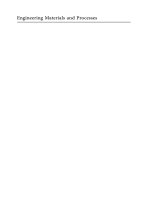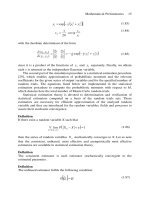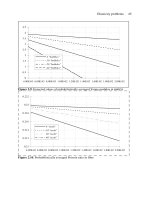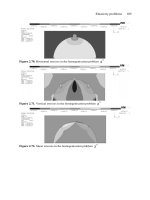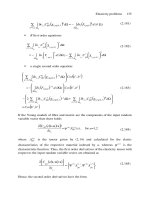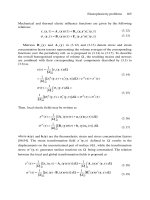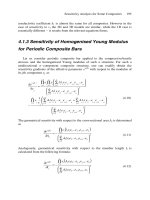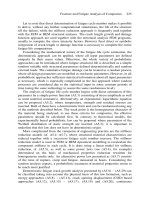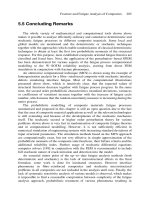The Behavior of Structures Composed of Composite Materials Part 14 pdf
Bạn đang xem bản rút gọn của tài liệu. Xem và tải ngay bản đầy đủ của tài liệu tại đây (933.42 KB, 30 trang )
384
The factor represents a measure of the constituent element packing geometry and
loading conditions. For example, for the transverse modulus is used while for
calculation of the in-plane shear modulus a value of is used. It should be
noted that the values of as given above provide reasonable predictions for the elastic
constants up to certain volume fractions of fiber packing density and also for reasonable
bounds on certain fiber geometries.
For predicting the fourth technical engineering constant, the major Poisson’s ratio
the rule of mixtures can again be used. Thus,
When considering anisotropic and twisted fibers, such as yarns, a modification of the
above formulae is necessary.
B. Physical properties
An important factor in determining the elastic properties of composites is
knowledge concerning the proportion of constituent materials used in the respective
lamina/laminates. These proportions can be given in terms of either weight fractions of
volume fractions. From an experimental viewpoint, a measure of the weight fractions is
easier to obtain than is the corresponding volume fractions of constituent elements.
There is however, an analytical connection between these proportioning factors which
allows conversion from weight to volume fraction and vice versa. Since volume fractions
are key to elastic properties calculations, this connection remains important. The
expressions necessary for this development follow.
Definitions
Volume Fractions Weight Fraction
f, m, c refer to fiber, matrix, composite respectively
In order to interrelate the above quantities analytically, we make use of familiar
density-volume relations. Thus,
385
refers to density
The above equation can be rewritten in terms of volume fractions by dividing thru by
.
Thus,
Equation (1) can be couched alternately in terms of constituent weights so that,
Dividing the above equation by we obtain
Introducing now the relationships between weight, volume and density, we have,
The relationship for and in terms of and can now be easily established
by inverting the above relations. Further, while the current derivation has been limited by
to two constituent elements, the extension to and the inclusion of multiple elements can
be easily made.
A relation between weight and volume fractions of fiber or matrix can thus be
analytically expressed in terms of the following equations
386
where,
Equations (2) has been plotted in Figure 11 for the following fiber types and
corresponding fiber densities as shown in Table 1.
This figure is useful for converting between weight and volume fraction of fibers
for respective materials. Other fiber types, with defined densities can be added to the
plotted data as inferred by interpolation. It should be noted that for volume fractions of
fiber greater than 75% care in the use of Figure 1 should be exercised. This is due to the
fact that there are theoretical as well as practical limits which can be attached to the
maximum allowable packing densities oriented with different fiber arrays. As specific
examples for the most common arrays encountered the square and hexagonal, the
maximum fiber volume fractions allowed would be 78% and 91% respectively. These
results can be obtained from simple analysis which is included below for the two most
common fiber packing geometries.
387
Fiber Packing Geometry
1. Hexagonal Array:
Consider triangle ABC
(Area occupied by the fibers)
Volume Fraction
388
2. Square Packing:
Consider a square ABCE
References
1.
2.
3.
4.
5.
6.
7.
8.
Ekvall, J.C. (1961) Elastic Properties of Orthotropic Monofilament Laminates, ASME
Aviation Conference, Los Angeles, California, 61-AV-56.
Ekvall, J.C. (1966) Structural Behavior of Monofilament Composites, AIAA/ASME
Structures, Structural Dynamics and Materials Conference, Palm Springs,
California, pp. 250.
Hill, R. (1965) Theory of Mechanical Properties of Fiber-Strengthened Materials –
Self Consistent Model, Journal of Mechanics and Physics of Solids, Vol. 13, pp.
189.
Hill, R. (1965) A Self-Consistent Mechanics of Composite Materials, Journal of
Mechanics and Physics of Solids, Vol. 13, pp. 213.
Whitney, J.M. (1966) Geometrical Effects of Filament Twist on the Modulus and
Strength of Graphite Fiber-Reinforce Composite, Textile Research Journal,
September, pp. 765.
Whitney, J.M. and Riley, M.B. (1966) Elastic Properties of Fiber Reinforced
Composite Materials, Journal of AIAA, Vol. 4, pp. 1537.
Hashin, Z. (1968) Assessment of the Self-Consistent Scheme Approximation –
Conductivity of Particulate Composites, Journal of Composite Materials, Vol. 2,
pp.
284.
Hashin, Z. (1965) On Elastic Behavior of Fiber-Reinforced Materials of Arbitrary
Transverse Phase Geometry, Journal of Mechanism and Physics of Solids, Vol.
13, pp.
119.
389
9.
10.
11.
12.
13.
14.
15.
16.
17.
18.
19.
20.
21.
22.
23.
Paul, B. (1960) Prediction of Elastic Constants of Multiphase Materials, Transactions
of the Metallurgy Society of AIME, Vol. 218, pp. 36.
Hashin, Z. and Rosen, W. (1964) The Elastic Moduli of Fiber-Reinforced Materials,
Journal of Applied Mechanism, Vol. 31, June, pp. 223, Errate, Vol. 32, 1965, pp.
219.
Hashin, Z. and Shtrikman, S. (1963) A Variational Approach to the Theory of the
Elastic Behavior of Multiphase Materials, Journal Mechanics and Physics of
Solids, pp. 127.
Schapery, R.A. (1968) Thermal Expansion Coefficients of Composite Materials
Based on Energy Principle, Journal of Composite Materials, Vol. 2, No. 3, pp.
380.
Adams, D.F. and Tsai, S.W. (1969) The Influence of Random Filament Packing on
the Transverse Stiffness of Unidirectional Composites, Journal of Composite
Materials, Vol. 3, pp. 368.
Adams. D.F. and Doner, D.R. (1967) Longitudinal Shear Loading of a Unidirectional
Composite, Journal of Composite Materials, Vol. 1, pp. 4.
Adams. D.F. and Doner, D.R. (1967) Longitudinal Shear Loading of a Unidirectional
Composite, Journal of Composite Materials, Vol. 1, pp. 152.
Chen, C.H. and Cheng, S. (1967) Mechanical Properties of Fiber-Reinforced
Composites, Journal of Composite Materials, Vol. 1, pp. 30.
Behrens, E. (1968) Thermal Conductivity of Composite Materials, Journal of
Composite Materials, Vol. 2, pp. 2.
Behrens, E. (1967) Elastic Constants of Filamentary Composite with Rectangular
Symmetry, Journal of Acoustical Society of America, Vol. 47, pp. 367.
Foye, R.L. (1966) An Evaluation of Various Engineering Estimates of the Transverse
Properties of Unidirectional Composites, SAMPE, Vol. 10, pp. 31.
Tsai, S.W. (1964) Structural Behavior of Composite Materials, NASA CR-71, July,
National Aeronautical and Space Administration CR-71.
Halpin, J.C. and Tsai, S.W. (1967) Environmental Factors in Composite Materials
Design, AFML-TR-67-423 Air Force Materials Laboratory, Wright-Patterson Air
Force Base, Ohio.
Tsai, S.W., Adams, D.F. and Doner, D.R. (1966) Effect of Constituent Material
Properties on the Strength of Fiber-Reinforced Composite Materials, AFML-TR-
66-190, Air Force Materials Laboratory.
Ashton, J.E., Halpin, J.C. and Petit, P.H. (1969) Primer on Composite Materials:
Analysis, Technonic Publishing Co., Inc., Stanford, Conn., pp. 113.
Appendix 2.
Test Standards for Polymer Matrix Composites.
As can be discerned from the test material, the role of the engineer in controlling
the design process using composite materials requires considerable expertise beyond
traditional levels for establishing design criteria. A fundamental input into any design
process is the requirement for obtaining the necessary materials properties data as well as
establishing the overall material response in order to identify the types of failure events
that can occur. Thus the data base for composites is an evolutionary process in which
current accepted test standards are being reviewed and revisions adopted as well as
composite modes of failure identified and tabulated.
As a ready means of access and awareness to the test procedures in current
practice, test standards have been included. It should be mentioned that in general the
engineer executes tests of the following type:
A.
B.
C.
Interrogative, that is, those examining some aspect, or is seeking fundamental
information on certain properties, relations, or physical constants of materials, those
using unique test apparatus.
Developmental, that is, those tests required to obtain additional data to ensure meeting
performance specifications on a selected material. In such cases both standard and
modified standard test equipment may be used by the engineer.
Standardized, that is, those tests which utilize controlled test procedures which have
been adapted from sanctioned test committee and professional engineering society
recommendations. Such tests are almost universally run using commercially
available test equipment and with specific geometry specimens.
While all three of the aforementioned type of tests provide important data, it is the
standardized test that we tend to rely upon when requiring data for materials. This is
especially true since engineers in general wish to be able to duplicate specific tests using
accessible equipment rather than designing totally unique test facilities. In view of these
statements, the following standards given in Table 1 are provided which describe a
number of common
mechanical tests. Details concerning the test specimen geometry and
procedures can be found in the appropriate standard.
Appreciation is expressed to Dr. Gregg Schoeppner, AFRL/MLBCM for his
contribution to Appendix 2.
392
Appendix 3. Properties of Various Polymer Composites.
Using such tests as described in the standards of Appendix 2, a listing of selected
material properties for continuous filament unidirectional composites is included as Table
A3-1 below.
The symbols used in Table A3-1 are:
Modulus of elasticity in the fiber direction
Modulus of elasticity perpendicular to the fiber direction
Major Poisson’s ratio, i.e.,
In-plane shear stiffness
Tensile strength in the fiber direction
Compressive strength in the fiber direction
Tensile strength normal to the fiber direction
Compressive strength normal to the fiber direction
In-plane shear strength
Fiber volume fraction
Coefficient of thermal expansion in the fiber direction
Coefficient of thermal expansion perpendicular to the fiber direction
Coefficient of moisture expansion in the fiber direction
Coefficient of moisture expansion perpendicular to the fiber direction.
For conversion from the psi units used in Table A3-1 for stress and modulus of
elasticity,
To determine the density of many of the composite materials given on the next
page, use the Rule of Mixtures of Section 2.4 (pp. 51-52), along with the fiber densities
given in Table 1 of Appendix 1 (pg. 387), and the polymer matrix densities given in
Table 1.2 (pg. 8).
394
395
Author Index
Abrate, S. 14, 58, 78
Adams, D.F. 389
Arbocz, J. 235
Argyris, J. 54, 77
Ashton, J.E. 389
Azzi, V.D. 312, 321, 326, 331
Baker, J.L. 253
Behrens, E. 389
Ben-Yosef, Y. 253, 254
Bert, C.W. 141, 142, 252-254
Bickley, W.G. 348
Birman, V. 253, 254
Bogdanovich, A.E. 36
Brull, M.A. 141, 243, 253
Burchill, P. 24, 36
Burk, R.C. 331
Burton, W.S. 54, 77
Carlsson, L.A. 50, 77
Causbie, S.M. 285, 299
Challes, K. 36
Chamis, C.C. 354, 356, 357
Chao, W.C. 142
Chaturvedi, S.K. 78
Chen, C.H. 389
Cheng, S. 389
Chou, T W. 41, 52, 77, 78, 141
Christensen, R.M. 50, 57, 77, 78
Critchfield, M. 26, 36
Crossman, F.W. 141, 339, 348, 356
Daniel, I.M. 57, 78
Daugherty, R.L. 173
Davies, G.J. 310, 331
DeBruyn, N.A. 334, 354
Dee, A.T.
200
Dickson, J.N. 335, 355
Dobyns, A.L. 116, 123, 124, 129, 142
Doner, D.R. 389
Dong, S.B. 252, 253
Ekvall, J.C. 388
Felgar, R., Jr. 132, 142, 183, 199, 200,
285,
299
Flaggs, D.L. 141, 337, 339, 343, 355,
356
Foye, R.L. 389
Fujita, A. 354, 356
Gandhi, K.R. 354
Gellert, E. 24, 36
Gere, J. 164, 200
Ghosh, S.K. 135, 142
Goland, M. 334, 339, 355
Greenberg, J.B. 253, 254
Grimes, G.C. 335, 336, 341, 355
Hahn, H.T. 50, 52, 77, 314, 331
Halpin, J.C. 50, 77, 389
Harris, C.E. 23, 36
Hart-Smith, L.J. 336, 337, 347, 355,
356
Hashin, Z. 50, 77, 388, 389
Hawley, A.V. 335, 341, 348, 350, 354,
355
Henderson, J. 129, 142
Hill, R. 311, 312, 326, 330, 331, 388
Hilton, H.H. 77, 79
Hofer, K.E. 334, 335, 348, 350, 355
Hoffman, O. 313, 314, 330, 331
Hsu, T.M. 335,
355
Hsu, Y.S. 253, 254
Huang, N.N. 54, 77
Hwu,
C.
133,
142
Inman, D.J. 129, 142
Jen, M.M. 354,
357
Jones, D.L.C. 129, 140
Jones, R.M.
Jurf, R.A. 57, 78
398
Kelly, A. 310, 331
Kerr, A.D. 135, 142
Kim, R.Y. 353,356
Koya, T. 260, 299
Kuno, J.K. 333, 354
Kutsche, D. 334, 335, 348, 350, 355
LaBedz, R.H. 58, 78
Lagace, P.A. 285, 299, 253, 354
Larson, P.H. 76, 79
Lee, C.K. 76, 79
Legon, J.B. 354, 356
Lehman, G.M. 335, 340, 341, 348, 349,
354,
355
Leibowitz, M. 76-79
Leissa, A.W. 121, 142
Lenoe, E.M. 350, 356
Levy, M. 102, 141
Liber, T. 58, 78
Lin, W.H. 354, 357
Lindholm, V.S. 57, 77
Liu, D. 354, 357
Liu, T.S. 310, 331
Marin, J. 311, 312, 331
Marshall, I.H. 54, 77
Matthews, F.L. 353, 356
McKinney, J.M. 335, 355
Mindlin, R.D. 75, 79
Minnetyan, L. 354, 357
Mirsky, I. 252, 253
Miskioglu, I. 354, 356
Moh,J.S. 133, 142
Moon,F.C. 76, 79
Morgan, S.L. 36
Mouritz, A.P. 24, 27, 28, 36
Mukhyapadyay, A.K. 138
Muha, T.J. 339, 355
Mura, T. 260, 299
Murphy, M.M. 350, 356
Murthy, P.L. 354, 356
Nashif, A.D. 129, 142
Nemeth, M.P. 253, 254
Newill, J.F. 76, 79
Nicholas, T. 58, 78
Noor, A.K. 54, 76
Norris, C.D. 312, 331
Nosier, A. 253, 254
Oplinger, D.W. 339, 341, 343, 346,
347, 354,
356
Osgood, W.R. 336, 355
Pagano, N.J. 66, 79
Pajerowski, J. 355
Paliwal, D.N. 135, 142
Paul, B. 389
Petit, P.H. 389
Pipes, R.B. 50, 77, 78
Potter, P.C. 36
Preissner, E.C. 237, 253
Rajapakse, Y.D.S. 58, 78
Raju, B.B. 354, 357
Ramberg, W. 336, 355
Rankine, W.J.M. 306, 331
Reddy, J.N. 141, 142, 253, 254
Reddy, V.S. 142
Reissner, E. 75, 76, 79, 286, 289, 293,
299, 334, 339,
355
Renton, W.J. 334, 337, 338, 346
Riley, M.B. 388
Ross, C.A. 252, 254
Roy, B.N. 252, 253
Running, D.M. 354, 356
Sandhu, R.S. 331
Sankar, B.V. 253
Schapery, R.A. 389
Sen, J.K.
356
Shames, I. 77
Sharpe, W.N., Jr. 339, 355
Shaw, D. 253, 254
Sheinman, I. 253, 254
Shen, C. 57
Sherman, I. 253, 254
Shuart, M.J. 23, 36
Sierakowski, R.L. 36, 58, 78, 138, 252,
254
Simitses, G.J. 253, 254
Sloan, J.G. 62, 68, 274, 299
399
Smeltzer, S.S., III 253, 254
Sokolnikoff, I.S. 36, 41, 77, 259, 299
Sottos, N. 32
Springer, G.S. 56, 78
Starnes, J.H., Jr. 23, 36, 253, 254
Stavsky, Y. 253, 254
Stockdale, J.H. 353, 356
Stowell, E.Z. 310, 331
Sun, C.T. 252-254, 354, 357
Szepe, F. 334, 354
Taraga, U.Y.R.S. 354, 357
Tasi, J. 252, 253
Tauchert, T.R. 54, 77
Tenek, L. 54, 77
Timoshenko, S. 109, 141, 164, 200
Tong, L. 354, 356
Tresca, H. 331
Tsai, S.W. 50, 66, 77, 78, 312, 313,
321, 326, 330, 331, 389
Tso, F.K.W. 252, 253
Turvey, O.J. 54, 77
Ulrich, D.R. 78
Van Siclen, R.C. 350-354, 356
Vinson, J.R. 41, 57, 58, 76-79, 106,
109, 114, 138, 141, 142, 200, 230,
243, 253, 254, 276, 285, 299, 337,
338, 339, 346, 347,
356
Vizzini, A.J. 253, 254
Volkersen, O. 334, 354
von Mises, R. 326, 331
Waddoups, M.E. 331
Walker, W.J. 78
Waltz, T. 230, 253
Wang, D.Y. 334, 354
Warburton, G. 132, 142, 183, 200, 285,
299
Wetherhold, R.C. 339, 356
White, J.C. 252, 253
White, S. 32
Whitney, J.M. 114, 141, 184, 200, 252-
254, 353,
356
Wilson, D.W. 58, 78, 141, 142
Woinowski-Krieger, S. 109, 141
Woldesenbet, E. 57, 78
Wu,
C.I.
299
Wu, E.M. 314, 330, 331
Yi, S. 77, 79
Yon, J. 354, 357
Young, D. 132, 142, 183, 199, 200,
285, 299
Yu, Y.Y. 76, 79
Zeng, Q.G. 354, 357
Zenkert, D. 138, 142
Zukas, J.A. 58, 78
Subject Index
A380 super jumbo jet 23
acetals 7, 13
acoustic signature 27
acryonitride – butadiene styrene (ABS) 7, 13
adaptive structures
adhesive 281, 282, 333, 335-338, 340, 342, 343
bonded joint 341, 347, 348
ductility 340
film thickness 335, 336
peel strength 346
shear stress 335-338, 347
stresses 335, 342, 344
tensile modulus 336
thickness effects 338
transverse normal stresses 336
adherends 334-337, 340, 347
advanced beam theory 184, 193
Advanced Enclosed Mast/Sensor (AEM/S)
aerodynamic smoothness 334, 340
aeroelastic tailoring 74
aerospace 19, 29
affine transformations 42
agriculture 32
AIAA 36
Airbus Industries 23
aircraft 19, 20, 22, 35, 89, 333
allowable
bearing load 351
loads 328
strain 320, 321, 325, 330
stress 34, 105, 111, 162, 184, 243, 247, 250, 306, 319, 322
Alta 25
aluminum 5, 23, 24, 27, 81, 350
6061-T6 81
amplitude ratio 297
angle 11
interlock composite 4
ply laminate 34, 73, 338, 368
of twist 137
402
anisotropic 27, 34
compliance matrix 40, 41
elastic stiffness matrix 40, 41
elasticity 39
failure theory 309
fiber 52
laminate 330
materials 39, 40, 306, 309, 311
strength 309
tensor 40
anisotropy 40, 259, 274, 311
antenna 26, 27
applied
lateral loads 135
load 243, 251
surface shear stresses 90, 91, 113
torque 243
aramid fibers 7, 51, 141
area moment of inertia 269
Arleigh Burke destroyers (DDG 51) 27
armored vehicle 32
artificial intelligence 364
A54
3501-6 graphite/epoxy 394
Peek (APC42) 394
aspect ratio 285
ASTM
C393-62 293
D638 55
D3846 55
D5229-92 77
Test Standards 392
asymmetric beam 183, 237
asymmetry 184, 240, 340
autoclave molding 12, 19
automobile 24, 35
Automotive Composite Alliance 24
Avenger class MCMV 27
axial
compression 244, 246, 251
displacements 178
equilibrium 178, 233
in-plane force 221
loads 184, 187, 243, 336
strain 341
stress resultant 178
403
stretching deformations 343
axially symmetric
cylindrical shell 240, 242, 243
in-plane loads 226
in-plane shear stresses 231
laminated shell 230
loads 222, 226, 228, 239-241
vibrations 252
axle joint 304
balanced joint 336
ballistic protection 28
balsa 28
beam 59, 66, 67, 73, 76, 87, 108, 129, 155-160, 164-173, 179-183, 186, 190, 199, 215,
244, 259, 262, 266, 289, 292, 293, 303, 368,
369
assumptions 261, 264
behavior 183
bending 160, 261, 262, 264
bending moment 290
cross-section 292
equations 165, 199, 261
mode shapes 182
natural frequencies 183
on an elastic foundation 221
transverse shear resultant 290
vibration
s
286, 293
beam-column 156
bending 106, 133, 138, 155, 244, 248, 251, 273, 290, 340, 345
boundary layer 227, 228, 230-234, 236, 237, 243
loads 135
moment 136, 161, 166, 170, 172, 243, 290
stiffness 293
stiffness matrix 246
strain energy 273
stresses 105, 117, 159, 266
bending-shearing coupling 74
bending-stretching coupling 73, 105, 113, 131, 138, 139, 180, 183, 185, 218, 276, 277
bending-twisting coupling 73, 106, 139, 140, 276, 277
biaxial
compressive load 133
stress state 236
bicycles 31
bi-harmonic operator 107
bi-modular materials 141
biodegradable composites 32
biological tissue 141
404
biomedical engineering 141
bird strike 179
blades 32
blast 27, 28
boat hulls 16, 28
body forces 88, 89, 260, 287
Boeing 23
bolt 333, 351, 380
bending 350, 351
clamping friction 350
joint strength 350
torque 350, 351, 353
bolted
double lap joint 350
joint 348-351
single lap joint 351, 353
bolted-bonded joint 348-350
boron
aluminum 151
epoxy 79-82, 394
epoxy unidirectional composite 372
fibers 8, 387
laminates 349, 350
boundary condition
94, 95, 103, 105, 107, 108, 113, 114, 120, 121,131, 132, 159, 160,
163, 165, 167-169, 172, 173, 179, 182, 190, 191, 196, 199, 222,
233, 235, 265, 266-268, 278, 283, 285, 286, 293, 296
box beam 135, 136
braided
composite 4, 34
preforms 12
brazing 333
breakage 305
bridge deck 28-30
brittle materials 309, 313
buckled plate 132
buckling 35, 57, 130-132, 135, 138, 140, 155, 158, 179, 197-199, 243, 244, 246, 248,
250-252, 259, 260, 274, 282, 365
analysis 244
loads 35, 39, 53, 88, 92, 131, 132, 134, 135, 156, 198, 199, 244, 246, 247, 274,
282,
284
modes 131, 132, 138, 198, 199
pressure 249
resistance 141
stress 243
buildings 28
405
bulk
matrix 305
modulus 39, 50, 378
bulkheads 28
buses 24
bushings 348, 349
cable stayed bridge 30, 31
canards 32
cantilevered beam 162, 163, 172, 184, 267, 268, 283
carbon
fibers 25, 27-29
fiber polymeric laminate 23
nanotubes 32
steel 5
carbon-carbon composites 6
cargo door assembly 24
carrier film sheets 21
Cartesian coordinate system 42, 43, 66, 217, 206, 293
catalyst 16
centrifugal forces 88
ceramic 76
matrix 7
composite 6
characteristic beam functions 285
chasses 35
chemical storage tanks 19
chopped
fiber composite 3, 23
fiber reinforcements 5, 17
rovings 21
chopper/spray gun 17
circular
cylindrical shell 215-217, 222-224, 226, 228, 232, 240, 241, 243, 276
hole 348
circumferential
coordinates 215
loads 231
stiffness 231
clamped edge 94, 105, 109, 110, 114, 160, 168-170, 222, 232, 233, 235-239, 264, 282,
285,
286
clamped-clamped beam 173, 184, 184, 267
clamped-free beam 170, 183, 184, 283
clamped-simply supported beam 172, 183, 267
Class A finish 16
406
classical
beam 160, 182, 197, 294
beam theory 70, 94, 155, 156, 182, 290, 292, 295, 298
plate theory 70, 91, 93, 94, 96, 111-113, 115, 124, 139, 215, 272
shell theory 70, 215
theory 68, 69, 91, 92, 96, 106, 111, 112, 120, 130, 135, 138, 182, 183, 252, 282,
290
cloth 20
clutch disks 24
cockpit cover 28
cold working 39
coefficient of
hygrothermal expansion 55, 59, 64, 276, 337, 393
moisture expansion 393
thermal expansion 1, 8, 53, 55, 59, 64, 192, 276, 334, 393
cold press molding 15, 16
collapse 35, 243
column 58, 87, 155, 160, 198, 199
combine 32
combined axial compression and
bendin
g
250
external pressure 251
hydrostatic pressure 251
torsion 252
combined loading 250, 316
failure theories 306
strength theories 306
commercial aircraft 22
compatibility equations 33, 34, 40, 66, 112
complete orthogonal set of functions 95
compliance matrix 46, 50, 316
Composite Worldwide Inc. 28
compressive
failure mode 348
failure strength 313
loads 131, 132, 135, 155, 158, 188, 199, 243, 244, 315
mechanical properties
140
modulus of elasticity 8, 184
stiffness
141
strength 305, 312, 315, 393
stresses 324
transverse loads 315
yield strength 306, 312, 314, 316
compression 320, 323, 325, 337
members 368, 369
molding 12-15
407
concentrated load 155, 168, 170, 171, 266, 267, 278
boundary conditions 259
conical shell 215
conservative system 119, 294
Consolidated Vultee B-36 Bomber 333
constant amplitude load 338
constituent properties 367
constitutive equations 33, 34, 40, 42, 63, 66, 67, 76, 87, 92, 112, 132, 138, 155, 156,
178, 183, 185, 194, 195, 218, 239, 246, 274, 275, 371, 375
contact molding 17
continuous
fibers 5, 6, 11
laminating process 21
load 167, 227
contour plots 368
contraction 55
control
element 40, 41, 88
volume 41
convolution integral 124-126
coordinate stretching 106
copper 1, 5
chloride 333
core 276, 281, 282
depth 281
material 281, 282
shear instability 138
Correspondence Principle 58
corrosion 24, 32, 35
prevention 334
resistance 27-29, 31
corrugations 21
countersunk fasteners 351, 353
coupled differential equations 183, 185
cosine load 118
costs 12, 15, 17, 25, 27, 333, 334
crack propagation 305
cracks 58
crash loads 119
creep
56, 141, 367
relaxation 339
critical
buckling load 245, 248, 282, 284, 285
load 131, 246
pressure 248, 249
408
torque 250
cross-link 7, 15
cross-ply laminates 34, 74, 75, 98, 99, 101, 133, 138
cure temperature 337
curvature 69, 73, 74, 87, 97, 105, 125, 140, 155, 156, 166, 215, 273, 280, 285, 330
curvilinear coordinate system 43, 217
cut-off saw 21
cyclic loading 35, 119, 179
cylindrical
shell 215, 228, 233, 244, 246, 248, 252, 368, 369
woven composite 4
d’Alembert’s Principle 120, 180, 184
damage 35, 304
damping 27, 75, 119, 129, 334
debond 347
decks 28
defects 305
deflection functions 273
deformation (displacement) 39, 66, 68, 75, 112, 133, 141, 158, 185, 189, 190, 192, 196,
215, 218, 232, 259-261, 270, 274, 276, 278, 279, 286, 288-
292, 294, 296, 329,
337
degradation 304
density 52, 387
design 33, 34, 58, 63, 65, 92, 94, 104, 105, 111, 129, 131, 132, 156, 173, 180, 182, 199,
216, 228, 233, 236, 249, 250, 259, 268, 270, 271, 303-305, 309, 316, 318, 323,
328, 333, 334, 338, 341, 346-353, 361-373, 391
design driver 303, 304
destroyer 27
differential
equation 242
operator 173
dilatational 65
energy 309
strain 41, 64
direction cosine 43
discontinuity 168
discontinuous
boundary conditions 259
fiber reinforced composite 5
flexural stiffness 167
load 165
thickness 267
displacement tensor 48
distortion energy criterion 308, 309, 326
double
409
doubler joint 335, 339, 340
lap joint 335, 336, 339-341, 344-346, 349, 350
sine series 132
drive shaft 24
ductile
adhesives 338
materials 309
matrices 309
metals 311
Duhamel integral 124
dynamic
deformations 289
effects 119, 180, 286
loads 35, 57, 119, 120, 124, 125, 129, 132, 179, 180, 184, 193, 199, 333, 348
magnification load factor 129
edge
delamination 305
displacement 230
distance 348-351, 353
effects 365
load solutions 222, 225, 243
moment 223-225
shear load 224
shear resultant 224
effective shear resultant 95
E-glass epoxy 98, 99, 191, 209, 212, 230, 358, 394
cross-ply composite 99, 100
laminate 101
E-glass fibers 6, 28, 387
E-glass/mat polyester 395
W.R. polyester 395
eigenfunctions 132, 199
eigenvalue problem 119, 120, 124, 132, 199, 259, 284
Einsteinian notation 89
elastic
body 260
constants 52
energy 308
foundation 115, 135, 221
foundation modulus 221
instability 35, 155, 179, 244
limit 337
perfectly plastic characterization 336
stiffness matrix 45
strain energy density function 57
410
elasticity
equations 65, 217, 289
matrix 44
tensor 42, 43
electrical
field intensity vector 75
insulation 334
potential 76
signature 27
transmission tower 268, 271
electromagnetic shielding 25
electro-rheological fluids 75
elliptical coordinate system 43
empirical factor 244, 247, 248, 351
energy
methods 87, 259
principles 261
theorems 260
solutions 266
engineering
analysis 371
plastics 5
shear strain 43
environmental effects 35, 310, 329, 367, 368
epoxy 7, 8, 13, 19, 24, 28, 29, 32, 52, 57, 58, 82, 309
equations of motion 293, 294
equilibrium equations 33, 34, 40, 66, 76, 87-91, 112, 132, 133, 138, 156, 157, 183, 184,
193, 217, 239, 240, 259, 260, 286, 289, 290, 292, 323,
341
equivalent lateral pressure 221
esthetic considerations 239
Euler coefficient 117
Euler-Lagrange equations 264, 286
exact solution 95
excessive wear 304
expert systems 364
experimental considerations 252
explosion 57
exponential
data 247
decay 223-227, 234
function 343
pulse loading 127, 129
extensional stiffness 136, 293, 335
behavior 183
matrix 73, 135, 246
strain 41
411
external pressure 243, 248, 249, 251
extrusion 11
fabric 21
reinforced composite 5
fabrication 39, 305, 364, 366
face 276, 281, 282
dimpling 138
material
281, 282
thickness 281
wrinkling instability 138
failsafe 323, 328, 330
design 325
failure 198, 199, 243, 303-307, 309-314, 322, 326, 347
analysis
305, 316, 328
characterization 304
criterion 303, 306, 312, 314, 315, 318, 321,326-328, 330
envelope 306, 328, 329, 348
initiation 304, 305
loads 336
mechanisms 305
modes 131, 198, 305, 336, 348, 349
strength 309, 310
stress
162, 247, 250
fasteners 348-351
fatigue 26, 27, 35, 350
cracks 335
damage 180
failure 119
life 334-350
resistance 334, 367
run-out 335, 337, 338, 350
specimens 335
strength 335
stress 27
tests 335, 338, 350
fiber 4, 21, 25, 27, 29, 304, 365, 367, 375
buckling 140
cutting 348
dominated failure 305
failure 328
materials 140
optics 5
orientation 246, 305, 351
packing geometry 378, 389
placement 19
